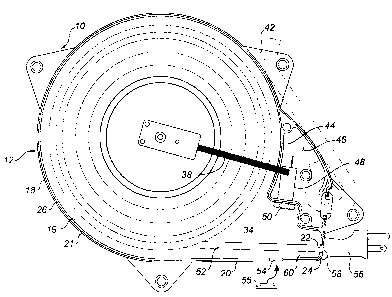Some of the information on this Web page has been provided by external sources. The Government of Canada is not responsible for the accuracy, reliability or currency of the information supplied by external sources. Users wishing to rely upon this information should consult directly with the source of the information. Content provided by external sources is not subject to official languages, privacy and accessibility requirements.
Any discrepancies in the text and image of the Claims and Abstract are due to differing posting times. Text of the Claims and Abstract are posted:
| (12) Patent: | (11) CA 2174057 |
|---|---|
| (54) English Title: | HOUSING FOR A RETRACTABLE CORD MECHANISM |
| (54) French Title: | LOGEMENT DE MECANISME D'ENROULEMENT DE CORDON |
| Status: | Term Expired - Post Grant Beyond Limit |
| (51) International Patent Classification (IPC): |
|
|---|---|
| (72) Inventors : |
|
| (73) Owners : |
|
| (71) Applicants : |
|
| (74) Agent: | NATHAN V. WOODRUFFWOODRUFF, NATHAN V. |
| (74) Associate agent: | |
| (45) Issued: | 2002-09-10 |
| (22) Filed Date: | 1996-04-12 |
| (41) Open to Public Inspection: | 1997-06-19 |
| Examination requested: | 1998-04-02 |
| Availability of licence: | N/A |
| Dedicated to the Public: | N/A |
| (25) Language of filing: | English |
| Patent Cooperation Treaty (PCT): | No |
|---|
| (30) Application Priority Data: | ||||||
|---|---|---|---|---|---|---|
|
A housing for a retractable cord mechanism includes a first body, a second body and a coupling for securing the first body to the second body in a water tight manner to create a composite body with an interior cavity. The composite body has a snout-like projection with an opening positioned at a terminus of the snout-like projection. The composite body is mounted with the snout-like projection angled downwardly such that any water splashed up into the interior cavity of the composite housing drains by force of gravity out of the opening at the terminus of the snout-like projection.
Un logement de mécanisme d'enroulement de cordon comprend un premier corps, un deuxième corps et un raccord permettant de fixer le premier corps au deuxième corps de manière étanche, afin de créer un corps composite avec une cavité intérieure. Le corps composite présente une saillie en forme de bec, avec une ouverture positionnée au niveau d'une extrémité de la saillie en forme de bec. Le corps composite est fixé avec la saillie en forme de bec inclinée vers le bas, de telle sorte que l'eau éclaboussée dans la cavité intérieure du logement composite se vide par la force de la gravité hors de l'ouverture se trouvant au niveau de l'extrémité de la saillie en forme de bec.
Note: Claims are shown in the official language in which they were submitted.
Note: Descriptions are shown in the official language in which they were submitted.

2024-08-01:As part of the Next Generation Patents (NGP) transition, the Canadian Patents Database (CPD) now contains a more detailed Event History, which replicates the Event Log of our new back-office solution.
Please note that "Inactive:" events refers to events no longer in use in our new back-office solution.
For a clearer understanding of the status of the application/patent presented on this page, the site Disclaimer , as well as the definitions for Patent , Event History , Maintenance Fee and Payment History should be consulted.
| Description | Date |
|---|---|
| Inactive: Expired (new Act pat) | 2016-04-12 |
| Appointment of Agent Requirements Determined Compliant | 2011-04-20 |
| Inactive: Office letter | 2011-04-20 |
| Inactive: Office letter | 2011-04-20 |
| Revocation of Agent Requirements Determined Compliant | 2011-04-20 |
| Small Entity Declaration Request Received | 2008-04-08 |
| Small Entity Declaration Determined Compliant | 2008-04-08 |
| Inactive: IPC from MCD | 2006-03-12 |
| Grant by Issuance | 2002-09-10 |
| Inactive: Cover page published | 2002-09-09 |
| Inactive: Final fee received | 2002-06-12 |
| Pre-grant | 2002-06-12 |
| Letter Sent | 2001-12-17 |
| Notice of Allowance is Issued | 2001-12-17 |
| Notice of Allowance is Issued | 2001-12-17 |
| Inactive: Approved for allowance (AFA) | 2001-12-03 |
| Amendment Received - Voluntary Amendment | 1999-01-12 |
| Inactive: Status info is complete as of Log entry date | 1998-07-22 |
| Letter Sent | 1998-07-22 |
| Inactive: Application prosecuted on TS as of Log entry date | 1998-07-22 |
| All Requirements for Examination Determined Compliant | 1998-04-02 |
| Request for Examination Requirements Determined Compliant | 1998-04-02 |
| Application Published (Open to Public Inspection) | 1997-06-19 |
There is no abandonment history.
The last payment was received on 2002-04-08
Note : If the full payment has not been received on or before the date indicated, a further fee may be required which may be one of the following
Please refer to the CIPO Patent Fees web page to see all current fee amounts.
Note: Records showing the ownership history in alphabetical order.
| Current Owners on Record |
|---|
| THE REEL-THING INNOVATIONS INC. |
| THE REEL-THING INNOVATIONS INC. |
| Past Owners on Record |
|---|
| RANDOLPH PETER NESS |